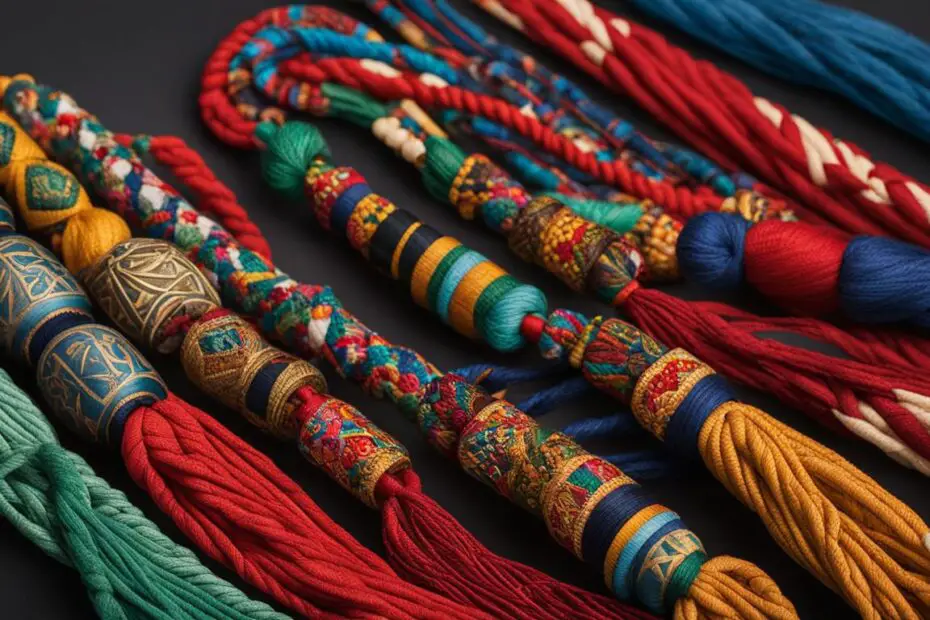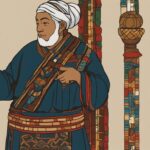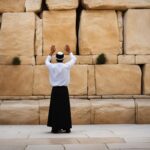Step back in time and discover the rich history and profound significance of the prayer rope. This timeless tradition has been passed down through the generations, carrying with it a deep spiritual connection to Orthodox Christian spirituality. From its mysterious origins to its continued use in the modern world, the prayer rope is a treasured tool that aids in the practice of unceasing prayer and fosters a stronger connection with God.
Key Takeaways:
- The prayer rope has a lengthy history dating back to the rise of monasticism in Egypt in the 3rd or 4th century AD.
- Origins of the prayer rope are believed to have emerged from simple forms of counting prayers, with a special kind of knot consisting of interlocked crosses becoming the basis for the prayer rope as we know it today.
- The prayer rope is not an amulet or magical object, but a purely Orthodox tool used for prayer by both monks and laypeople.
- Symbolism is deeply woven into the prayer rope, with black wool symbolizing repentance and the knots representing the victory of Christ over sin and death.
- Using the prayer rope aids in the practice of unceasing prayer, fostering a consistent prayer life and helping to overcome distractions.
The Significance of the Prayer Rope
The prayer rope holds great significance in Orthodox Christian spirituality. It is more than just a simple tool for counting prayers; it is a physical embodiment of faith and a powerful symbol of spiritual connection.
Traditionally made of black wool, the prayer rope symbolizes repentance and humility. Through its tactile presence, it serves as a constant reminder to turn inward and seek God’s mercy.
The knots in the rope are often tied in the form of interlocked crosses, representing the victory of Christ over sin and death. Each knot is a testament to the redemptive power of prayer and the divine love that conquers all.
Over time, prayer ropes have evolved to include beads or markers that help the user keep count of their prayers. These additions not only facilitate the counting process but also deepen the user’s engagement with the prayers themselves.
Whether in the form of knots or beads, the prayer rope serves as a physical guide through the spiritual journey. It aids in concentration, allowing the mind to focus solely on the words of prayer, and offers a tangible means of tracking progress on the path to spiritual growth.
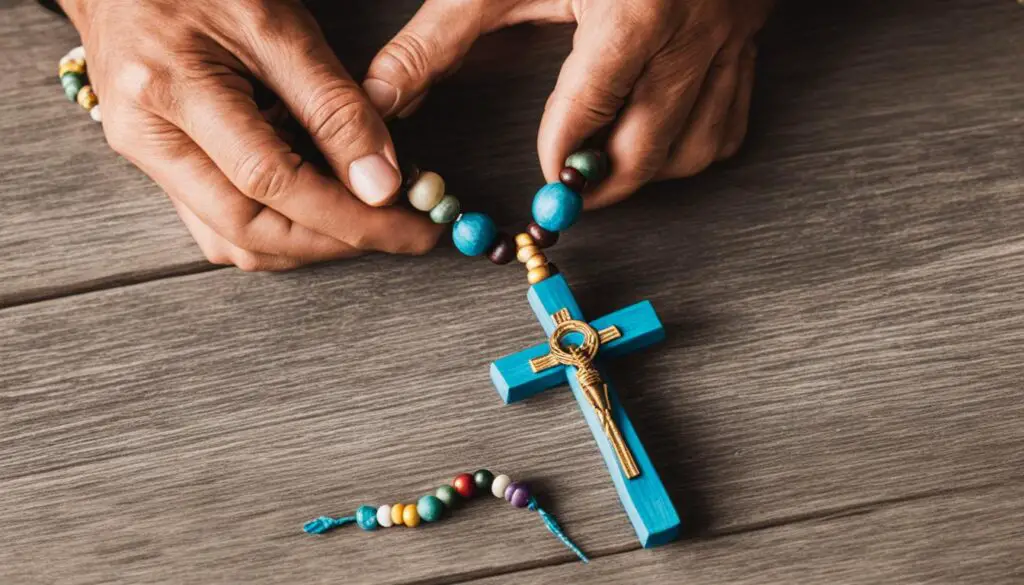
“The prayer rope is a tangible reminder of our connection to God and the power of prayer. As we hold it in our hands, we are reminded to pray without ceasing, to seek God’s presence in every moment of our lives.”
Indeed, the prayer rope encourages the development of a stronger spiritual life by fostering discipline, mindfulness, and a continuous state of prayer. It serves as a sacred link between the earthly and heavenly realms, guiding the believer toward a deeper understanding of their faith and a closer relationship with God.
The Use of the Prayer Rope
The prayer rope is a sacred tool deeply ingrained in Orthodox Christian tradition. Its usage is rooted in both ancient practices and contemporary spiritual disciplines. There are two main ways to use the prayer rope, each serving a unique purpose in fostering a consistent and focused prayer life.
-
Praying Anytime, Anywhere
One can use the prayer rope at any time of the day, whenever there is a moment of free time. Simply hold the prayer rope and move from knot to knot with the thumb while simultaneously reciting a prayer such as the Jesus Prayer: “Lord Jesus Christ have mercy on me” or “Most Holy Theotokos save us.” This practice allows for a constant connection with God in the midst of daily activities and helps to center the mind on prayer.
-
Following a Prayer Rule
Another way to use the prayer rope is during regular prayer times by following a prayer rule recommended by a spiritual father. With each knot on the prayer rope, the user makes the sign of the cross with the right hand and recites the designated prayer. This method assists in establishing a structured prayer routine and aids in overcoming distractions. It serves as a guide to navigate through various prayers and facilitates a deeper engagement with the Divine.
Regardless of the method used, the prayer rope serves as a tangible reminder of the sacredness of prayer and the continuous presence of God in our lives. Its consistent usage cultivates a habit of prayer, strengthens spiritual discipline, and deepens the bond with the Divine.
A Comparison of Prayer Rope Usage Methods
| Usage | Benefits | Key Practices |
|---|---|---|
| Praying Anytime, Anywhere |
|
|
| Following a Prayer Rule |
|
|
Through the utilization of the prayer rope, individuals can embark on a transformative journey of prayer, deepening their relationship with God and nourishing their spiritual growth.
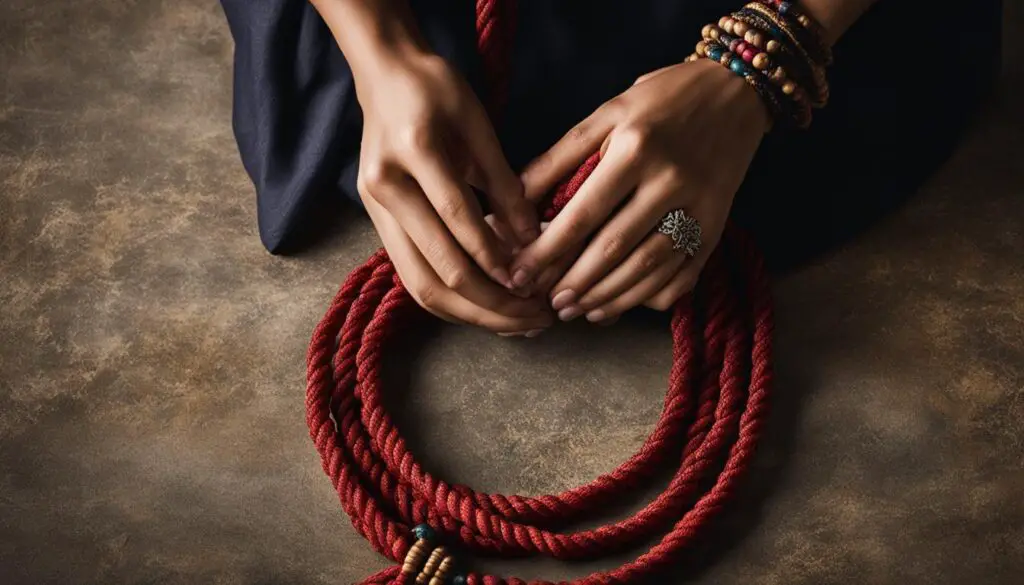
The Origins of the Prayer Rope
The exact origins of the prayer rope are lost in antiquity, but its historical background can be traced back to simple forms of counting prayers. In the early centuries of Christianity, monks and devout individuals sought ways to keep track of their prayers and ensure their devotion remained steadfast. These early methods involved moving pebbles or seeds from one spot to another, representing each prayer offered.
“The prayer rope holds a profound spiritual significance and serves as a tool to deepen one’s connection with God.”
– Father Gregory, Orthodox Christian Scholar
According to a sacred story, a monk attempted to use knots in a rope as a means of counting his prayers. However, the devil would untie the knots, disturbing the monk’s focus and devotion. In a divine intervention, an angel visited the monk and revealed a special kind of knot consisting of interlocked crosses.
This new knotting technique proved to be untangleable, and the prayer rope, adorned with these unique interlocked crosses, was born.
The Symbolism of the Prayer Rope
The prayer rope’s design, with its interlocked crosses, carries profound symbolism within Orthodox Christianity. Each knot represents a prayer offered, demonstrating the faith and devotion of the user. The interlocked crosses symbolize the victory of Christ over sin and death, highlighting the central message of the Christian faith.
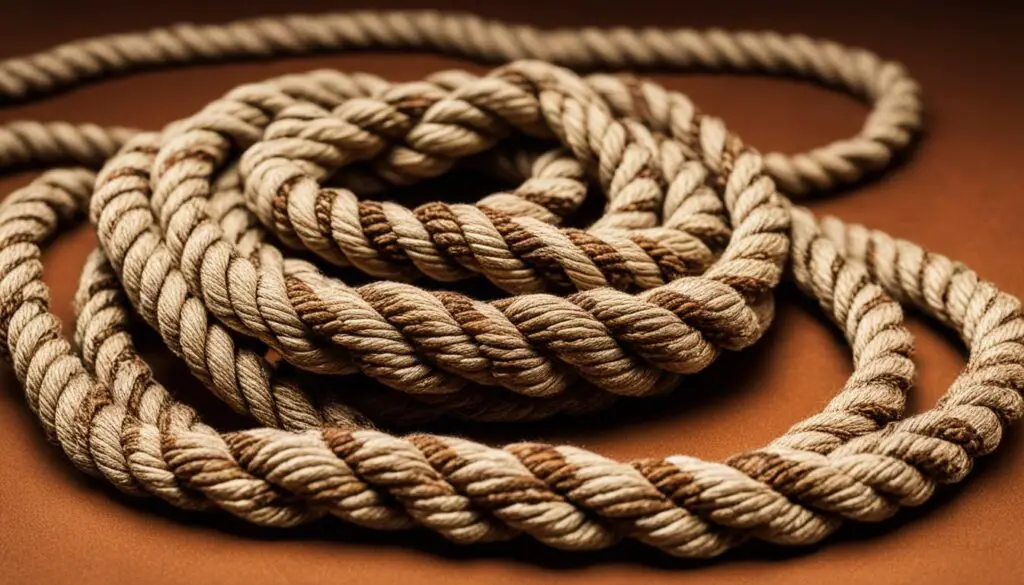
Furthermore, the prayer rope’s construction often includes a cross woven into it or attached as a marker at the end. This serves as a reminder of Christ’s sacrifice and acts as a focal point for prayer.
Incorporating the prayer rope into one’s spiritual practice reinforces the commitment to a consistent and disciplined prayer life, enabling individuals to draw closer to God and experience His transformative presence.
The Orthodox Prayer Rope Tradition
The prayer rope has a rich history and a significant place within the Orthodox Christian tradition. Monks, who dedicate their lives to deepening their spiritual connection with God, receive a prayer rope at the time of their tonsure. This sacred item serves as a spiritual weapon in their ongoing battle against the temptations of the devil.
Traditionally, the prayer rope is seen as a means to invoke the name of Jesus and seek His mercy. It symbolizes a constant presence of prayer in the lives of the faithful, reminding them of the importance of maintaining a deep connection with God. Prayer ropes come in various forms and sizes, with a cross woven into them or attached to mark the end. These crosses serve as a reminder of the victory of Christ over sin and death.
Moreover, prayer ropes often have markers after several knots or beads, which help the user keep count during prayer. These markers allow individuals to engage in uninterrupted, focused prayer without getting lost in the count of repetitions. As a result, the prayer rope tradition enhances the prayer experience by facilitating a deeper connection with God.
Below is a table highlighting the different forms and variations of prayer ropes:
| Type of Prayer Rope | Description |
|---|---|
| Simple Woolen Rope | A basic prayer rope made of black wool, symbolizing repentance and humility |
| Rope with Cross | A prayer rope with a cross woven into it or attached to mark its end, symbolizing the victory of Christ |
| Beaded Prayer Rope | A prayer rope with beads or knots at regular intervals, allowing the user to keep count during prayer |
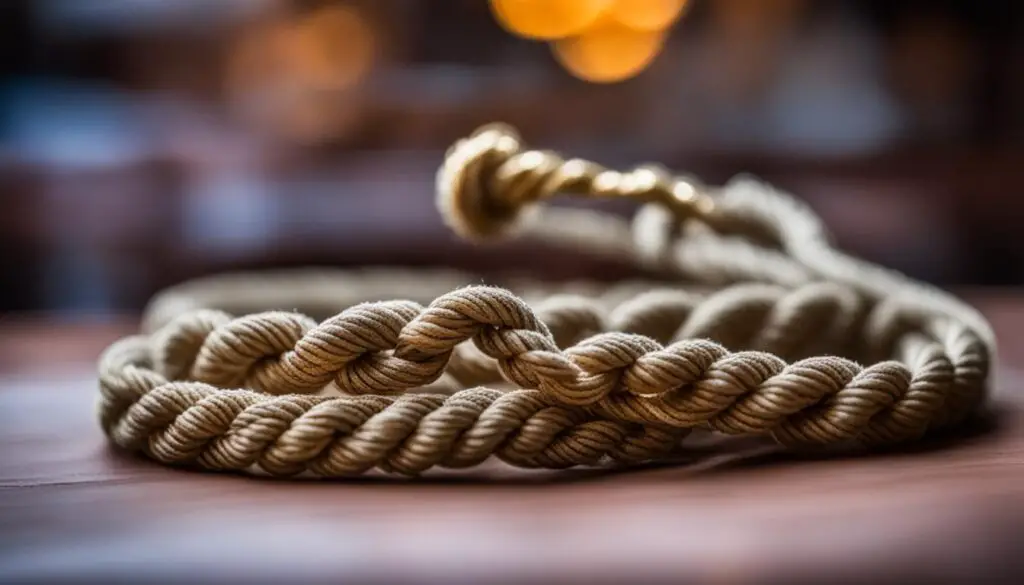
Through the centuries, the prayer rope tradition has remained an integral part of Orthodox Christian spirituality. It continues to be cherished by monks, nuns, and laypeople alike as a powerful tool for deepening their prayer life and fostering a stronger connection with God. The prayer rope invites individuals to embrace the rich tradition of Orthodox spirituality as they journey towards spiritual transformation and unity with God.
The Jesus Prayer and the Prayer Rope
The use of the prayer rope is intrinsically connected to the profound practice of the Jesus Prayer. This prayer serves as a powerful means to center one’s thoughts and intentions on God, allowing individuals to cultivate a deeper connection with the divine.
The Jesus Prayer is a simple repetition of the name of Jesus, such as “Lord Jesus Christ, Son of God, have mercy on me, a sinner.” It is a constant invocation of God’s mercy and presence, a spiritual mantra that helps individuals enter into a state of focused prayer.
When combined with the prayer rope, the process becomes even more transformative. By using the prayer rope to count the repetitions of the Jesus Prayer, individuals can establish a rhythm of prayer that becomes an integral part of their daily lives. This develops a habitual practice of unceasing prayer, aligning one’s heart and mind with God’s presence throughout the day.
The symbolism of the prayer rope further enhances the significance of this prayer practice. The knots in the rope, tied in the form of interlocked crosses, represent the victory of Christ over sin and death. They serve as a tactile reminder of the redemptive power of Christ’s sacrifice and the continuous need for repentance and spiritual growth.
Similarly, the presence of a cross woven into the prayer rope or attached at the end reinforces the centrality of Christ in this spiritual discipline. It serves as a visual reminder of His ultimate sacrifice and the profound love He has for humanity.
Benefits of the Jesus Prayer and the Prayer Rope
The combination of the Jesus Prayer and the prayer rope offers numerous benefits for spiritual growth and transformation. By engaging in this practice, individuals can:
- Develop a deeper connection with God through focused prayer
- Cultivate a habit of unceasing prayer, keeping God in constant remembrance
- Discipline the mind to overcome distractions and enter into a state of spiritual tranquility
- Experience the transformative power of God’s presence in their lives
It is through the intertwining of the Jesus Prayer and the prayer rope that individuals can embark on a profound spiritual journey, deepening their relationship with God and nurturing their innermost being.
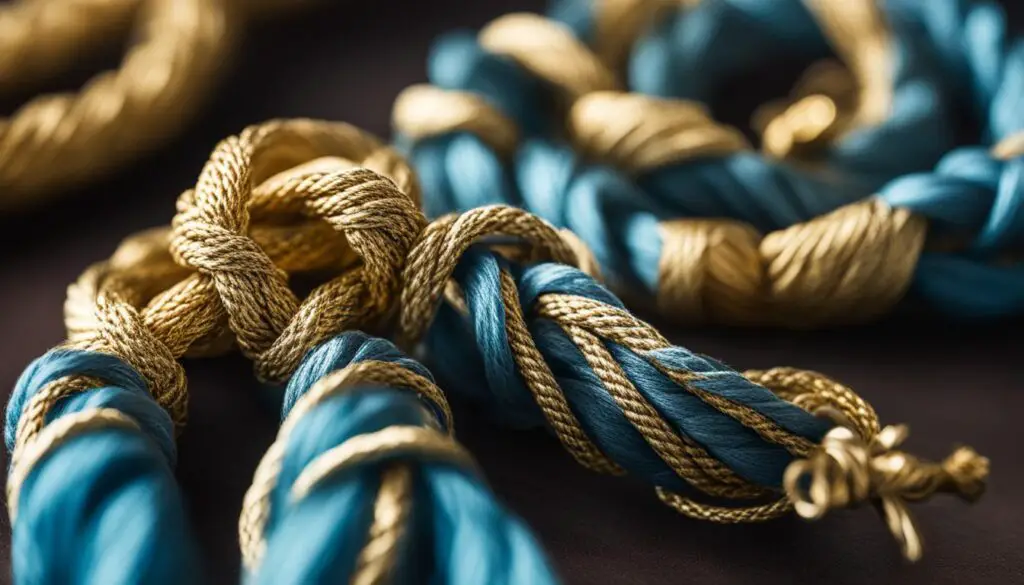
The Prayer Rope and Private Prayer
The prayer rope, a cherished tool in Orthodox Christian spirituality, holds a special significance in private, or interior, prayer known as the Prayer of the Heart. This form of prayer seeks to attain continuous communion with God and is often prescribed as a personal ascetic practice.
By utilizing the prayer rope during private prayer, individuals can cultivate a focused and uninterrupted prayer life, even in the face of distractions. The prayer rope serves as a gentle reminder to persevere in prayer, helping to keep the mind and heart concentrated on God.
“Private prayer is the soul’s sanctuary, where we can pour out our hearts and seek communion with God in the depths of our being.”
Through the intimate use of the prayer rope, individuals can experience a profound sense of connection with the divine, strengthening their relationship with God and nurturing their spiritual growth. This sacred practice aligns with the rich tradition of prayer rope usage throughout history.
Benefits of the Prayer Rope
Using the prayer rope during private prayer offers several benefits:
- Enhanced focus: The tactile nature of the prayer rope helps to center the mind and concentrate thoughts on prayer, enabling a deeper level of focus and intention.
- Overcoming distractions: The repetitive counting of knots or beads on the prayer rope provides a physical guide, helping to overcome distractions and maintain a sustained state of prayerful awareness.
- Constant reminder: The presence of the prayer rope serves as a continuous reminder to engage in regular prayer, encouraging the development of a consistent and dedicated prayer life.
The Power of Private Prayer
Private prayer deepens the personal relationship between an individual and God. It provides a sacred space for heartfelt communion and allows for a more intimate expression of faith. The use of the prayer rope within this private prayer practice amplifies its potency, helping individuals establish and nurture a rich spiritual connection that permeates their entire being.
“Private prayer is not about seeking recognition from others; it is about seeking the presence of God in the depths of our souls.”
In this digital age filled with constant noise and distractions, private prayer with the aid of the prayer rope offers a sanctuary of stillness and tranquility. It allows individuals to retreat from the outside world and find solace in the presence of God, fostering a deeper sense of spiritual well-being.
| Benefits of Using the Prayer Rope in Private Prayer |
|---|
| Enhanced focus |
| Overcoming distractions |
| Constant reminder |
The Practice of Hesychasm with the Prayer Rope
Hesychasm, or stillness, is a spiritual practice that aims to attain union with God through prayer and deep inner stillness. The prayer rope plays a crucial role in this practice by offering a tangible means to recite the Jesus Prayer and maintain a state of constant prayer. By repeating the Jesus Prayer with the aid of the prayer rope, individuals can enter into a state of deep spiritual tranquility and experience the transformative power of God’s presence.
Throughout history, Hesychasm has been embraced by Orthodox Christians as a way to cultivate a profound sense of inner stillness and contemplation. The prayer rope serves as a physical reminder of the need for continuous prayer and helps individuals anchor their thoughts and intentions in the presence of God. As they move from one knot to another, reciting the Jesus Prayer, they immerse themselves in a state of focused devotion and connect with the divine essence.
The significance of the prayer rope in Hesychasm lies in its ability to silence the distractions of the world and draw the practitioner closer to God. Through the repetitive recitation of the Jesus Prayer, individuals quiet their minds and enter into a state of profound stillness, where they can hear the whispers of the Holy Spirit and experience the transformative power of divine grace.
The Transformative Power of Hesychasm
“In the stillness of prayer, we find the strength to overcome our temptations and the courage to embrace the divine within us. The prayer rope becomes a lifeline, connecting us to the eternal source of love and peace.”
The practice of Hesychasm with the prayer rope is not limited to monastics; it is open to all who seek a deeper spiritual connection. By incorporating this practice into their daily lives, individuals can cultivate a sense of inner peace and develop a profound awareness of God’s presence.
Through the regular use of the prayer rope, individuals can experience a gradual transformation of their thoughts, desires, and actions. As they immerse themselves in the repetitive recitation of the Jesus Prayer, they align their hearts and minds with the divine will, allowing it to shape and guide their lives. The prayer rope becomes a companion on their spiritual journey, a constant reminder that they are never alone, and a tangible expression of their deep longing for union with God.
| Benefits of Hesychasm with the Prayer Rope |
|---|
| Deepens spiritual devotion and intimacy with God |
| Enhances focus and concentration in prayer |
| Helps to overcome distractions and temptations |
| Fosters a sense of inner peace and tranquility |
| Strengthens the practice of unceasing prayer |
As individuals engage in Hesychasm with the prayer rope, they embark on a profound spiritual journey that leads them closer to the heart of God. The practice becomes a way of life, a continuous communion with the divine, and a source of spiritual nourishment and guidance.
By embracing the practice of using the prayer rope in Hesychasm, individuals can experience the fullness of life in Christ and cultivate a deep sense of joy, peace, and love. The prayer rope becomes a faithful companion on their journey, a tangible reminder of their commitment to prayer and a sacred tool that connects them to the timeless traditions of Orthodox spirituality.
Conclusion
The prayer rope has a rich history and holds significant meaning within Orthodox Christian spirituality. It serves as a tool for prayer, a reminder for continuous communion with God, and a weapon in the spiritual battle against temptation and distraction.
By embracing the practice of using the prayer rope, individuals can deepen their prayer life, foster a stronger connection with God, and experience the transformative power of constant prayer. The prayer rope serves as a tangible reminder to prioritize prayer and seek God’s presence in every moment.
Through the repetition of the Jesus Prayer and the tactile experience of the prayer rope, individuals can cultivate a habit of unceasing prayer and develop a heightened spiritual awareness. The prayer rope invites believers to engage in a conversation with God and seek His mercy and guidance throughout the day.
As a powerful spiritual tool, the prayer rope offers a pathway to intimacy with God and facilitates a deeper understanding of Orthodox Christian spirituality. By incorporating the prayer rope into their prayer practice, individuals can embark on a journey of spiritual growth, finding solace, strength, and transformation in the constant presence of the Divine.
FAQ
What is the history of the prayer rope?
The prayer rope dates back to the rise of monasticism in Egypt in the 3rd or 4th century AD and is believed to have been established through angelic visitations. It has a long history deeply rooted in biblical symbolism.
What is the significance of the prayer rope?
The prayer rope is a tool used for prayer in Orthodox Christianity. Made of black wool, it symbolizes repentance, and the knots tied in the form of interlocked crosses represent the victory of Christ over sin and death. It serves as a constant reminder to pray without ceasing and encourages the development of a stronger spiritual life.
How is the prayer rope used?
There are two main ways to use the prayer rope. Firstly, it can be used at any time of the day by moving from knot to knot with the thumb while simultaneously praying the Jesus Prayer. Secondly, it can be used during regular prayer times by following a prayer rule recommended by a spiritual father. The prayer rope helps foster a consistent prayer life and overcome distractions.
What are the origins of the prayer rope?
The exact origins are lost in antiquity, but it is believed to have emerged from simple forms of counting prayers, such as using pebbles or seeds. According to a story, a monk attempted to use knots in a rope, but the devil was able to untie them. An angel then taught the monk a special kind of knot consisting of interlocked crosses, which became the basis for the prayer rope as we know it today.
What is the Orthodox prayer rope tradition?
The prayer rope is deeply ingrained in the Orthodox Christian tradition. Monks receive a prayer rope at the time of their tonsure as a spiritual weapon in their battle against the devil. It comes in various forms and sizes, with a cross woven into it or attached to mark the end. There are also markers after a certain number of knots or beads to help keep count during prayer.
How does the prayer rope relate to the Jesus Prayer?
The Jesus Prayer is central to the use of the prayer rope. By repeating the name of Jesus and using the prayer rope to count the repetitions, individuals can develop a deeper connection with God and cultivate a habit of unceasing prayer. The symbolism of the prayer rope reinforces the spiritual significance of this prayer practice.
How does the prayer rope enhance private prayer?
The prayer rope is particularly useful in private prayer, also known as the Prayer of the Heart. By using the prayer rope, individuals can develop a focused and uninterrupted prayer life, even in the face of distractions. It serves as a reminder to persevere in prayer and helps keep the mind and heart concentrated on God.
What is the practice of Hesychasm with the prayer rope?
Hesychasm is a spiritual practice that aims to attain union with God through prayer and deep inner stillness. The prayer rope plays a crucial role in this practice by offering a tangible means to recite the Jesus Prayer and maintain a state of constant prayer. By using the prayer rope, individuals can enter into a state of deep spiritual tranquility and experience the transformative power of God’s presence.
What is the conclusion about the prayer rope?
The prayer rope has a rich history and holds significant meaning within Orthodox Christian spirituality. It serves as a tool for prayer, a reminder for continuous communion with God, and a weapon in the spiritual battle against temptation and distraction. By embracing the practice of using the prayer rope, individuals can deepen their prayer life, foster a stronger connection with God, and experience the transformative power of constant prayer.


